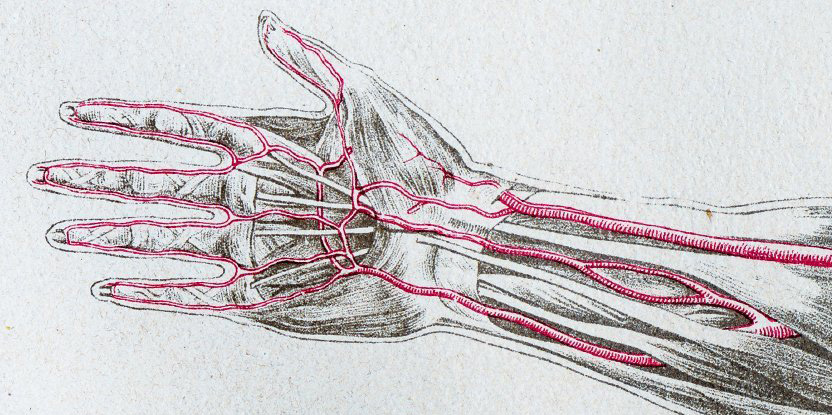
Posted on 10/09/2020 11:03:16 AM PDT by Red Badger

Picturing how our species might appear in the far future often invites wild speculation over stand-out features such as height, brain size, and skin complexion. Yet subtle shifts in our anatomy today demonstrate how unpredictable evolution can be.
Take something as mundane as an extra blood vessel in our arms, which going by current trends could be common place within just a few generations.
Researchers from Flinders University and the University of Adelaide in Australia have noticed an artery that temporarily runs down the centre of our forearms while we're still in the womb isn't vanishing as often as it used to.
That means there are more adults than ever running around with what amounts to be an extra channel of vascular tissue flowing under their wrist.
"Since the 18th century, anatomists have been studying the prevalence of this artery in adults and our study shows it's clearly increasing," says Flinders University anatomist Teghan Lucas.
"The prevalence was around 10 percent in people born in the mid-1880s compared to 30 percent in those born in the late 20th century, so that's a significant increase in a fairly short period of time, when it comes to evolution."
The median artery forms fairly early in development in all humans, transporting blood down the centre of our arms to feed our growing hands.

Three major arteries in the forearm - median in the centre
At around 8 weeks, it usually regresses, leaving the task to two other vessels – the radial (which we can feel when we take a person's pulse) and the ulnar arteries.
Anatomists have known for some time that this withering away of the median artery isn't a guarantee. In some cases, it hangs around for another month or so.
Sometimes we're born with it still pumping away, feeding either just the forearm, or in some cases the hand as well.
To compare the prevalence of this persistent blood channel, Lucas and colleagues Maciej Henneberg and Jaliya Kumaratilake from the University of Adelaide examined 80 limbs from cadavers, all donated by Australians of European descent.
The donors raged from 51 to 101 on passing, which means they were nearly all born in the first half of the 20th century.
Noting down how often they found a chunky median artery capable of carrying a good supply of blood, they compared the figures with records dug out of a literature search, taking into account tallies that could over-represent the vessel's appearance.
The fact the artery seems to be three times as common in adults today as it was more than a century ago is a startling find that suggests natural selection is favouring those who hold onto this extra bit of bloody supply.
"This increase could have resulted from mutations of genes involved in median artery development or health problems in mothers during pregnancy, or both actually," says Lucas.
We might imagine having a persistent median artery could give dextrous fingers or strong forearms a dependable boost of blood long after we're born. Yet having one also puts us at a greater risk of carpal tunnel syndrome, an uncomfortable condition that makes us less able to use our hands.
Nailing down the kinds of factors that play a major role in the processes selecting for a persistent median artery will require a lot more sleuthing.
Whatever they might be, it's likely we'll continue to see more of these vessels in coming years.
"If this trend continues, a majority of people will have median artery of the forearm by 2100," says Lucas.
This rapid rise of the median artery in adults isn't unlike the reappearance of a knee bone called the fabella, which is also three times more common today than it was a century ago.
As small as these differences are, tiny microevolutionary changes add up to large-scale variations that come to define a species.
Together they create new pressures themselves, putting us on new paths of health and disease that right now we might find hard to imagine today.
This research was published in the Journal of Anatomy.
Interesting. One of my other random thoughts is that viruses are and have been essential in transferring genetic changes across human populations. This may already be a known thing. I’m a techie, not a geneticist dammit. :)
I have thought that since I was a preteen and refer to it as “evolition” as opposed to “evolution”. I believe the field of epigenetics is coming around to this as well.
What I want to know is why folks in the Old Testament lived for hundreds and hundreds of years and today seems that eighty years is the norm.
Of course this is not an example of evolution. It’s not even an example of natural selection.
It’s an interesting observation that 1) needs to be defined clearly and validated and the 2) the reason for it can be studied.
I would guess if real it has to do with nutrition, similar to our being taller than previous generations (or fatter).
I’ve noticed there seems to be a lot more left handed people than there used to be......................
Simply more variation within species.
Certainly not creating a new one.
That is amazing, and 1870 is not long ago at all when you consider how far back humans date. Makes me wonder if the Egyptians from 5,000 years ago were a foot tall lol lol
In a pig’s artery.
That was bad.
5.56mm
That’s incredible, I think if we could go back in time and see that live we would be utterly shocked how small people were. It really shows how much nutrition and disease can hinder growth
Notice also how the headline is false, i.e. a lie.
The article does not say humans are growing a new artery. It says this artery is lost over time in childhood but now seems to be lasting longer than previously observed.
It’s similar to if baby teeth were lost at a slightly older age.
If the DNA does not account for the ‘extra’ artery, then, it’s not evolution.
If the artery is not inherited by all the generations that follow those individuals who have it, then, it’s not evolution. High intelligence is not necessarily inherited by the generations that follow those intelligent humans.
Ugliness is not necessarily inherited either, and neither is beauty.
The extra artery is used to keep the middle finger erect.
“Not enough generations for natural selection to create this change.”
Yes. These articles are nonsense (not the observations about the artery per se).
And this crap is from SCIENCE publications for the lay readership, ostensibly articles which should be scientifically valid but aren’t.
“This is a genetic mutation not ‘evolution’ but labeled as such to get everyone’s dander up.”
What evidence is there this is a genetic mutation?
Sure would. That is micro.
There is a reason Eskimos have an average 500 cholesterol count.
This is not “evolution”. This is “selection”, which sometimes is “natural selection”
The artery exists, and it sometimes doesn’t go away. It used to be that it went away almost all the time, but now for an unknown reason, people are inheriting genes that keep it around.
Could be simple random chance. Could be there is something about the set of genes involved that are also giving some breeding advantage. Or it could simply be that this has been coming for a long time, but we finally got enough people with it that we hit a tipping point.
Remember, EVOLUTION is when something mutates in a way we think is “better”. Selection is when that mutation gains some advantage, so that it is propagated. Most of what people describe as evolution is simple selection.
Micro evolution is demonstrable. Always has been.
Big difference.
It is like the enzyme we now keep to allow us to digest milk as adults. It is not new, it just does not switch off.
The body gets rid of things that are no longer being used. If they are still in use they are kept.
Wouldn't this be more-properly described as an example of devolution?
If you believe in neoteny, that is.
Regards,
Disclaimer: Opinions posted on Free Republic are those of the individual posters and do not necessarily represent the opinion of Free Republic or its management. All materials posted herein are protected by copyright law and the exemption for fair use of copyrighted works.